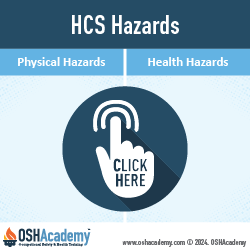Application of the Standard
The HCS applies to any chemical which is known to be present in the workplace in such a manner that employees may be exposed under normal use or in a foreseeable emergency.
Any Chemical: means any chemical which is classified as a physical hazard or a health hazard, a simple asphyxiant, combustible dust, pyrophoric gas, or hazard not otherwise classified. Even though an employer was not responsible for the manufacture of the hazardous chemical, the employer has the responsibility for transmitting information about the hazardous chemical to his or her employees.
In the Workplace: This refers to any location, whether indoors or outdoors, where work is performed by employees under the control of an employer. This includes all areas where hazardous chemicals are produced, used, stored, or otherwise present, and where employees might be exposed to these chemicals during their job duties or in foreseeable emergencies.
Known to be Present: The HCS applies to chemicals that are physically present in a workplace, regardless of whether they are actively being used. This includes chemicals in storage, those being handled or processed, and those contained within machinery or equipment. By covering "any chemical" known to be present, the HCS ensures comprehensive protection for workers, addressing both routine and unexpected exposures.
Employee Exposure: The rule is concerned with any situation where employees might come into contact with hazardous chemicals. The HCS covers both physical hazards (such as flammability, reactivity, or explosiveness) and health hazards (like toxicity, carcinogenicity, or corrosiveness). "Exposure" is defined not only as direct contact but also as any situation where a worker might inhale, ingest, or otherwise absorb the chemical, either through routine work activities or due to accidents or malfunctions.
Normal Use: The HCS covers chemicals that employees are exposed to during the normal, intended use of a product. For example, if a chemical is used as a cleaning solvent and workers are exposed to it during routine cleaning activities, this would fall under the scope of the HCS.
Foreseeable Emergency: The standard also applies to situations where chemicals might be released unexpectedly, such as spills, leaks, equipment failures, or other emergencies that could reasonably be anticipated. The goal is to prepare employees for the possibility of exposure in these scenarios, ensuring they know how to protect themselves and respond appropriately.
Knowledge Check Choose the best answer for the question.
1-4. The HCS applies to any chemical which is known to be present in the workplace in such a manner that employees may be exposed _____.
You forgot to answer the question!

